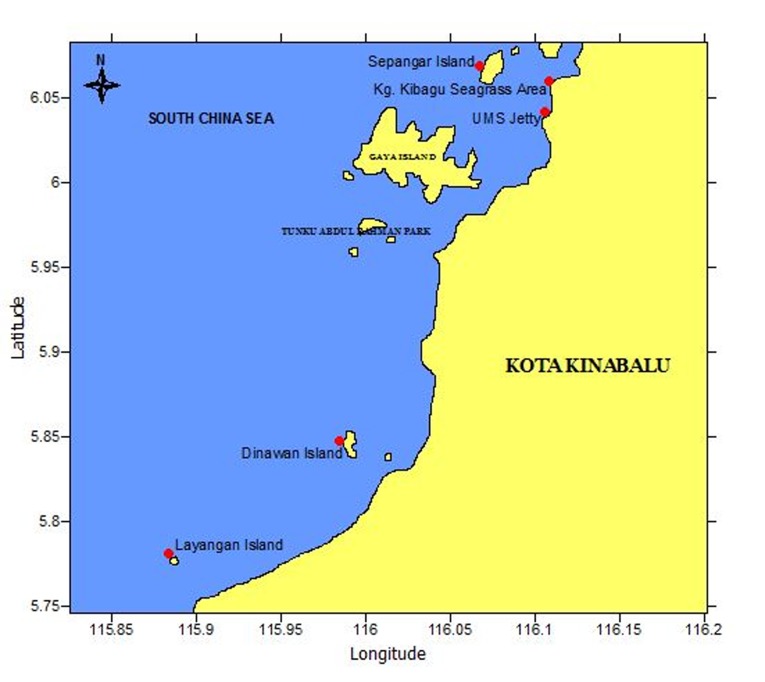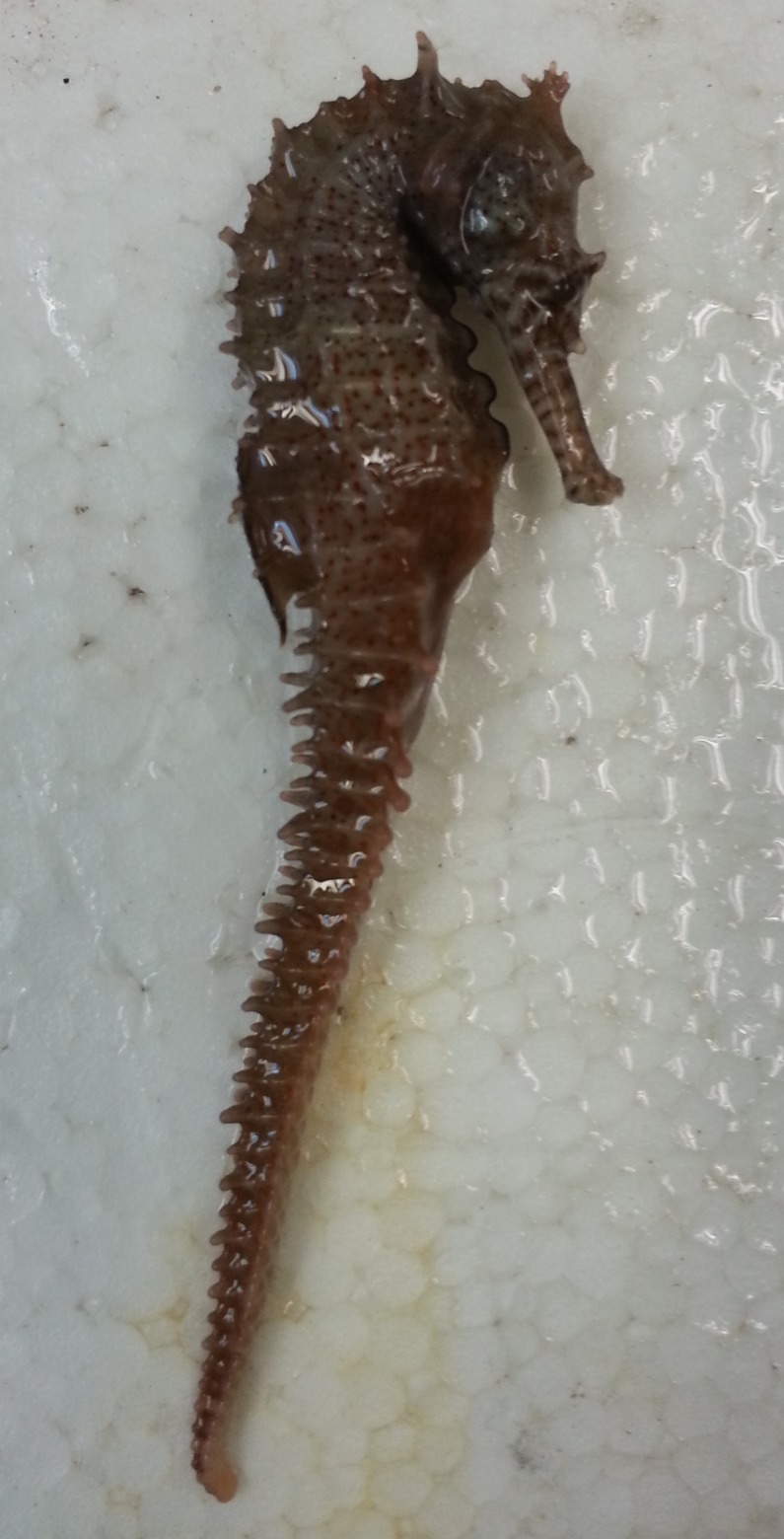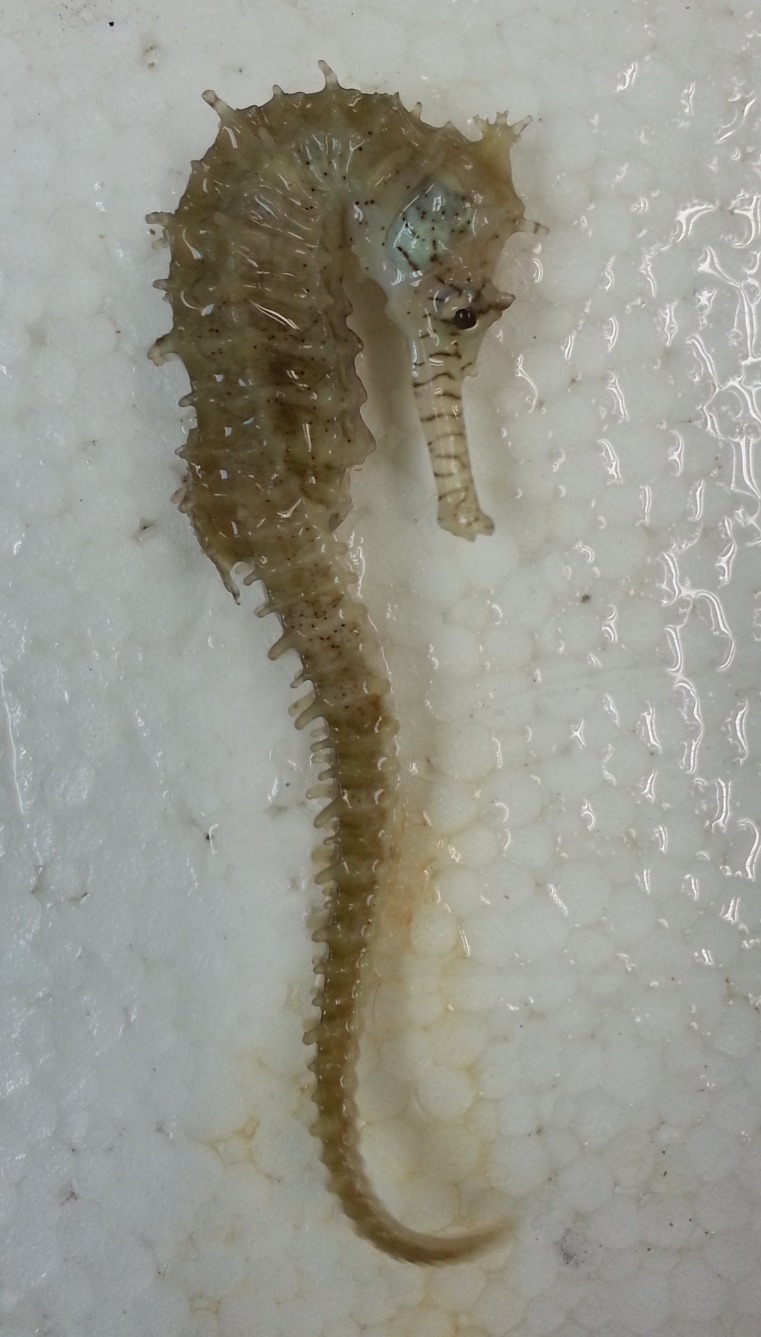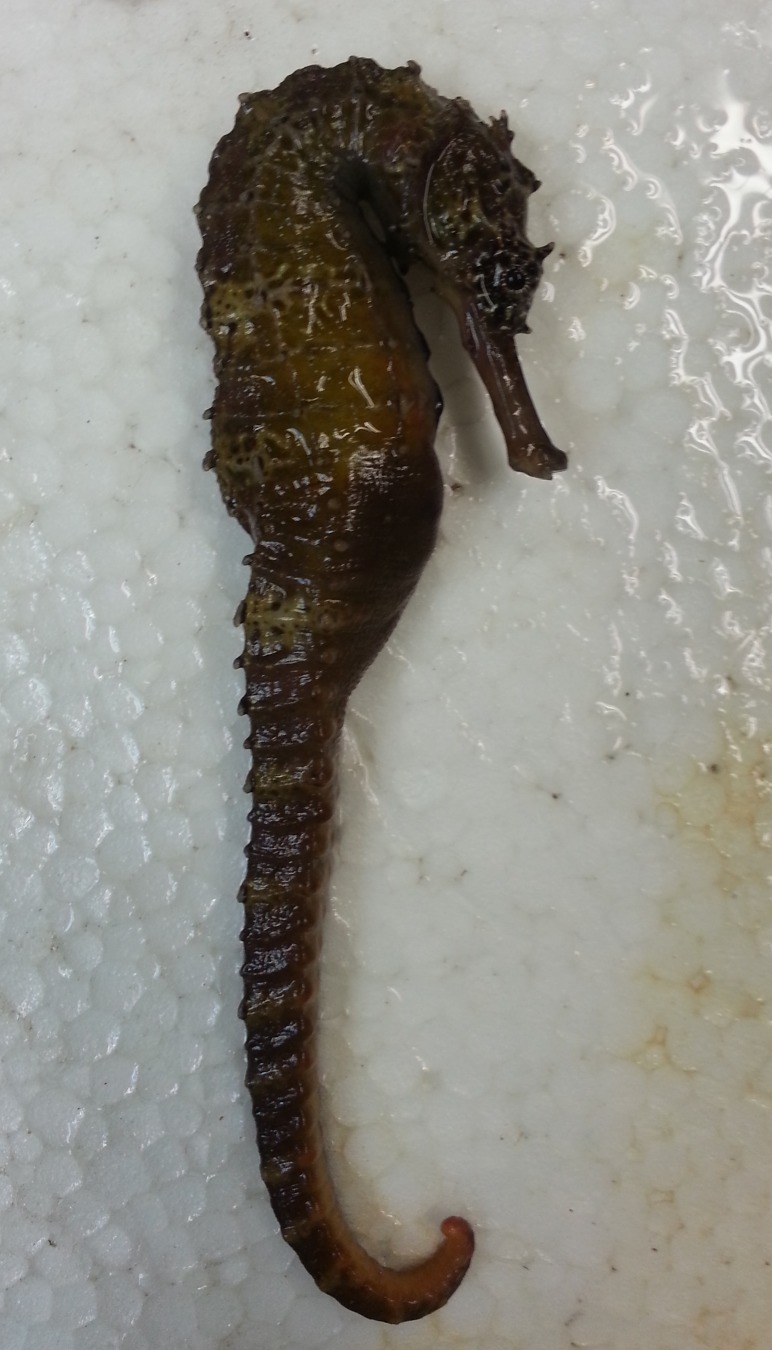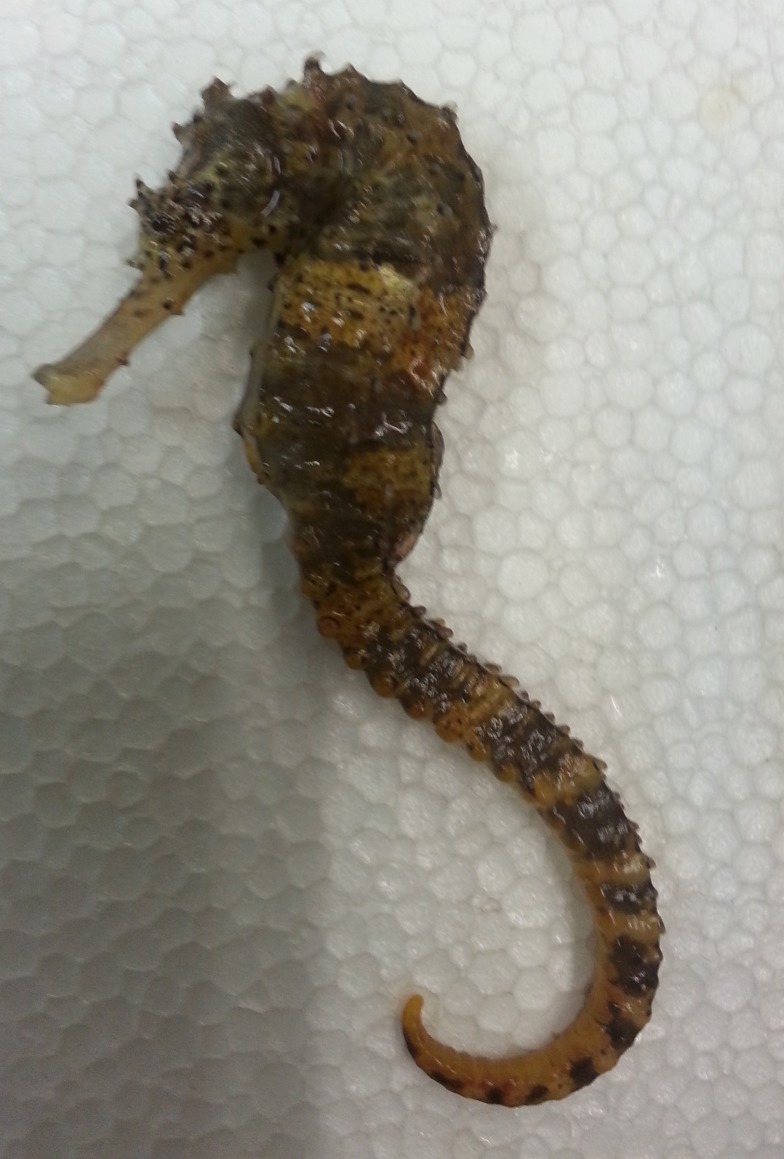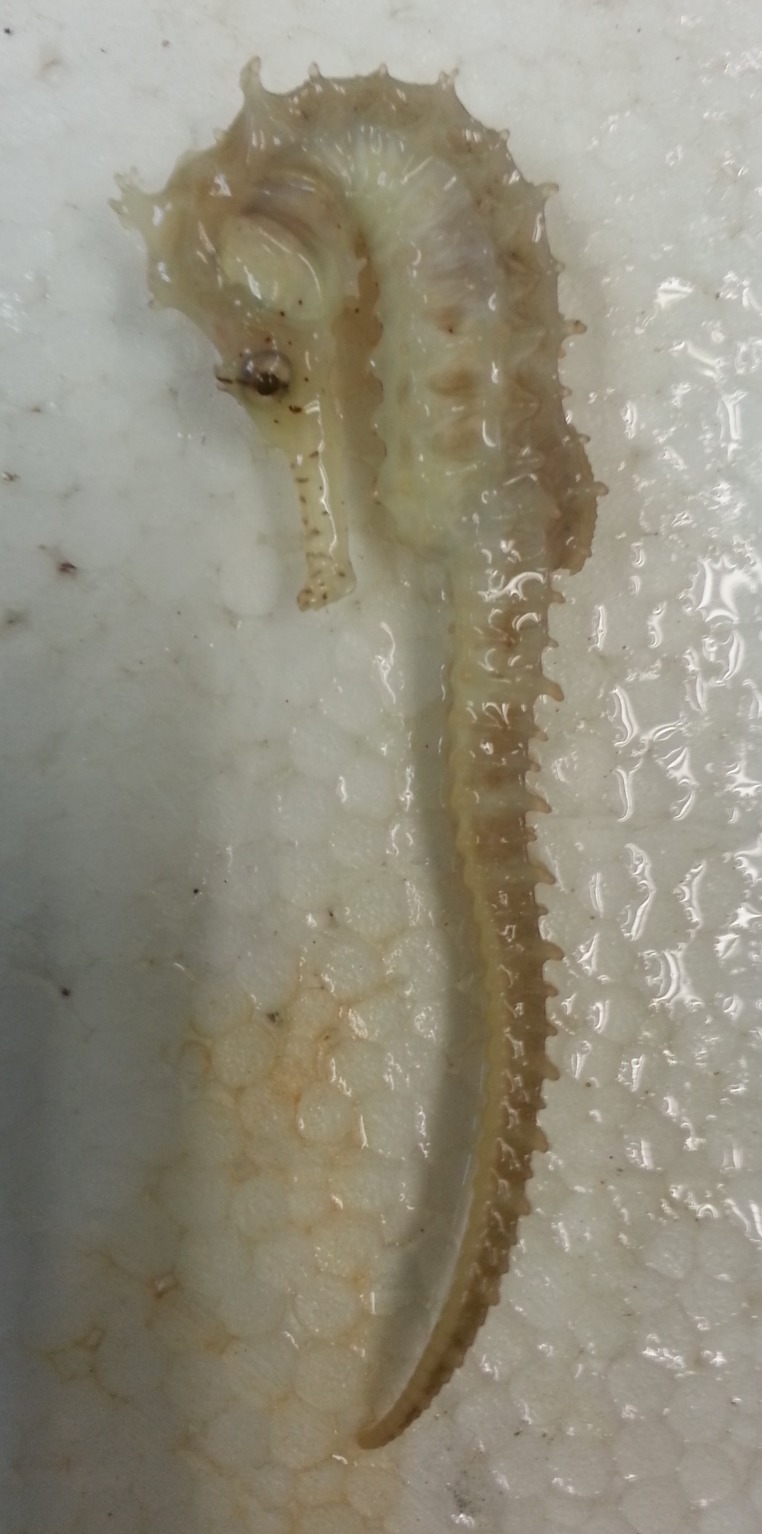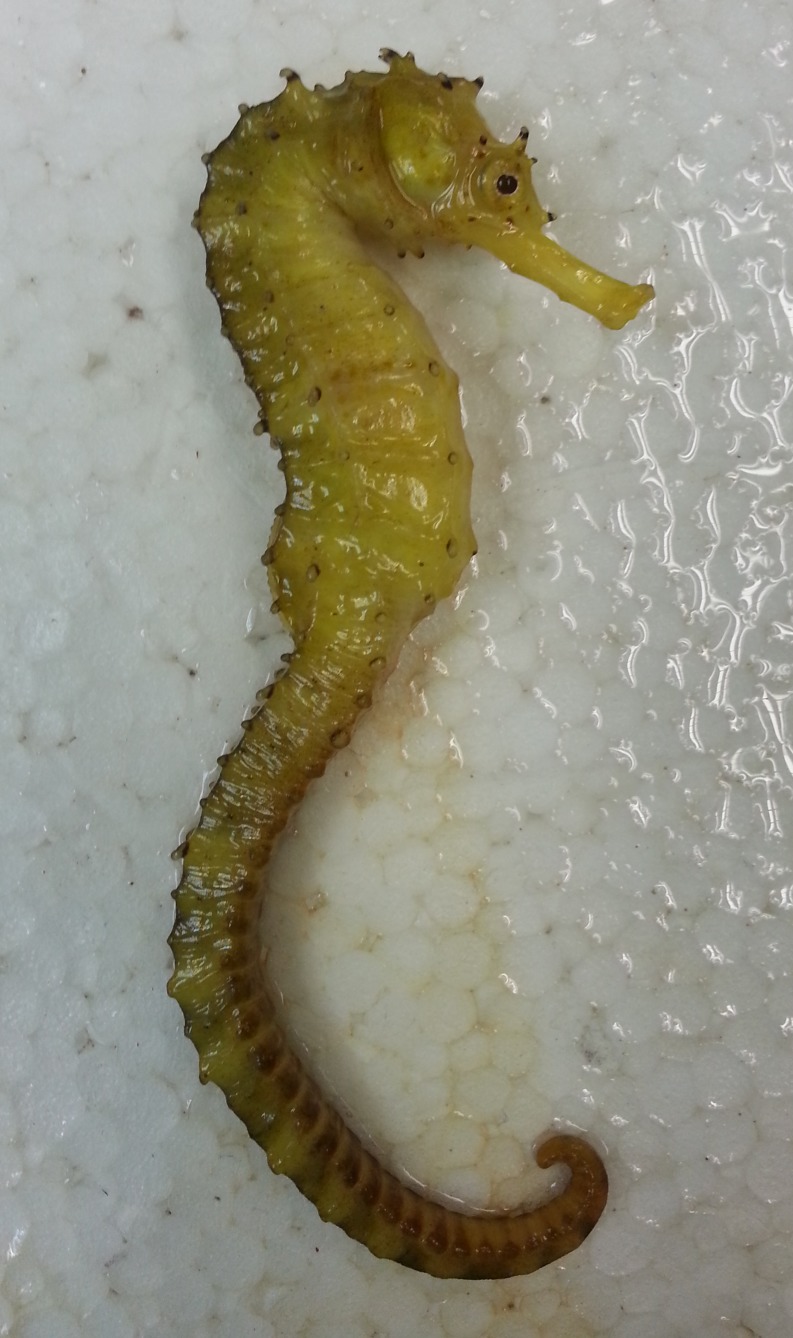Abstract
Seahorse diversity (genus Hippocampus, Family Syngnathidae), species identification, size composition and sexual dimorphism were studied from November 2012 to March 2013 in selected coastal waters around Kota Kinabalu, Sabah and the local market trade. Six species of seahorses were identified in the study: (1) Hippocampus barbouri, (2) Hippocampus comes, (3) Hippocampus kelloggi, (4) Hippocampus kuda, (5) Hippocampus spinosissimus and (6) Hippocampus trimaculatus. All six species were sold at the local market, and the dried seahorses were obtained mainly by local fishermen using trawl by-catch method and traded as traditional medicine, souvenirs and other uses. Four species were identified by direct samplings in various different habitats of Kota Kinabalu coastal waters: (1) H. barbouri, (2) H. comes, (3) H. kuda, and (4) H. spinosissimus. Based on the results, H. comes was the largest in size among the four fresh/live species found (mean standard length [SL]: 148.25±1.26 mm), whereas H. barbouri was the smallest species (mean SL: 129±7.81 mm). For the dried samples, H. kelloggi was the largest (mean SL: 245.25±14.55 mm) and H. barbouri was the smallest (mean SL: 127.21±10.01 mm). No significant difference (p>0.05) was observed between the lengths of males and females in every seahorse species, and there was no sexual size dimorphism in any of the species. The findings from the study are significant to provide baseline data for the conservation efforts of these unique marine teleost.
Keywords: Seahorse Diversity, Species Identification, Size Composition, Sexual Dimorphism, Kota Kinabalu Coastal Waters and Local Trade Market
Abstract
Kepelbagaian kuda laut (genus Hippocampus, Famili Syngnathidae), komposisi saiz dan perbezaan saiz berdasarkan jantina telah dikaji pada bulan November 2012 sehingga Mac 2013 di kawasan-kawasan terpilih sekitar perairan dan pasar tempatan di Kota Kinabalu, Sabah. Sebanyak enam spesies kuda laut telah dikenal pasti melalui kajian ini iaitu: (1) Hippocampus barbouri, (2) Hippocampus comes, (3) Hippocampus kelloggi, (4) Hippocampus kuda, (5) Hippocampus spinosissimus dan (6) Hippocampus trimaculatus. Kesemua enam spesies dijual di pasaran tempatan dan didapati bahawa kebanyakan kuda laut kering adalah hasil daripada tangkapan pukat tunda dan didagangkan sebagai ubat tradisional, cenderamata dan untuk kegunaan lain. Sebanyak empat spesies iaitu (1) H. barbouri, (2) H. comes, (3) H. kuda dan (4) H. spinosissimus telah ditemui menggunakan kaedah penyampelan secara terus di habitat yang berbeza sekitar perairan Kota Kinabalu. H. comes adalah yang terbesar dalam kalangan empat spesies hidup yang ditemui (min standard length [SL]: 148.25±1.26 mm), manakala H. barbouri adalah yang paling kecil (min SL: 129±7.81 mm). Bagi sampel kering, H. kelloggi adalah yang terbesar (min SL: 245.25±14.55 mm) dan H. barbouri adalah yang terkecil (min SL: 127.21±10.01 mm). Tiada perbezaan ketara (p>0.05) antara panjang jantan dan betina serta tiada perbezaan saiz berdasarkan jantina dalam setiap spesies. Sebagai kesimpulan, hasil kajian ini adalah penting bagi memberikan beberapa data asas dalam usaha pemuliharaan teleost marin yang unik ini.
Keywords: Kepelbagaian Kuda Laut, Pengenalpastian Spesies, Komposisi Saiz, Perbezaan Saiz Mengikut Seksualiti, Perairan Kota Kinabalu dan Pasar Dagangan Tempatan
INTRODUCTION
Seahorses (Genus Hippocampus, Family Syngnathidae) are unusual and valuable for a number of reasons, including their unusual biology, unique anatomy, economic value, and conservation, as well as their ecological importance and alleged medicinal properties (Shapawi et al. 2013). They have been exploited for several reasons, including for use in traditional medicine or as ornamental fish, and they have good market value and demand, which eventually made them vulnerable to exploitation and considered threatened (Vincent 1996).
Seahorse species populations, diversity, and distribution in Malaysia have not been adequately studied. Information on the exploitation and trade of seahorses is also deficient. Regular assessments on the population abundance, size-frequency distribution and sex ratio of any fish species can be used to track trends (increasing, equilibrium, decreasing) in the local population abundance. Furthermore, a continuous assessment in many sites provides useful information about species distributions, habitat use and the impacts of large-scale environmental disturbances (English et al. 1994; King 1995). The basic biological information compiled during seahorse population assessments might be useful as important baseline information available for use by marine biologists to evaluate the impacts of a planned or unexpected disturbance event on the local seahorse community. The density, size distribution, sex ratio and reproductive activity of a species can give insight into the life history and responses to disturbance. The structure of a population can also be used to estimate life history parameters, such as growth, survival and reproductive rates (King 1995). The present study investigated the diversity, size composition and sexual size dimorphism of Hippocampus spp. found in Kota Kinabalu, Sabah.
MATERIALS AND METHODS
Collection of Specimens and Surveys
Samplings and surveys were carried out from November 2012 to March 2013 in seven selected study areas for fresh/live samples: (1) Dinawan Island, (2) Layangan Island, (3) Sepanggar Island, (4) Universiti Malaysia Sabah (UMS) Jetty, (5) Kampung Kibagu, (6) Gaya Island and (7) Tanjung Aru. Meanwhile, the dried samples obtained from the local market were mostly caught by the local fishermen from Gaya Island and Tanjung Aru. Live seahorses were collected by direct samplings performed through roving snorkelling or scuba diving at the sampling sites (Fig. 1). Some specimens were purchased from fishers who used a variety of fishing gear, such as trawlers, seine nets, trammel nets, portable traps, purse seines, cast nets and scoop nets, or they were hand-picked. Fresh or recently dead seahorses that were either obtained from the fisherman or caught during direct sampling were immediately preserved in a jar with 10% of formalin solution for further species identification purposes. For the dried samples, a market survey was conducted in the Salted Fish Market, Kota Kinabalu, Sabah. Interviews, together with a set of questionnaires, were used as instruments to gather information from the respondents (mainly the sellers) on catch methods, trade routes, origins, price, commercial value and uses. The dried seahorses were also borrowed from the sellers and visually identified to the species level.
Figure 1:
Map of coastal areas of Kota Kinabalu. The red dots indicate the sampling sites for the seahorse survey.
Species, Sex and Standard Length Identification
All of the fresh/live and dried specimens collected were photographed, identified to species level and sexed, and the standard length (SL) measurements (sum of head length, trunk length and tail length) were recorded according to the standards provided by Lourie et al. (2004) (Fig. 2). All of the measurements were taken to the nearest millimetre (0.1 mm), and the meristic count was also used. The sexes were distinguished externally based on the presence or absence of a brood pouch on adult seahorses. The mean SL were calculated for all of the collected males and females of each Hippocampus spp.
Figure 2:
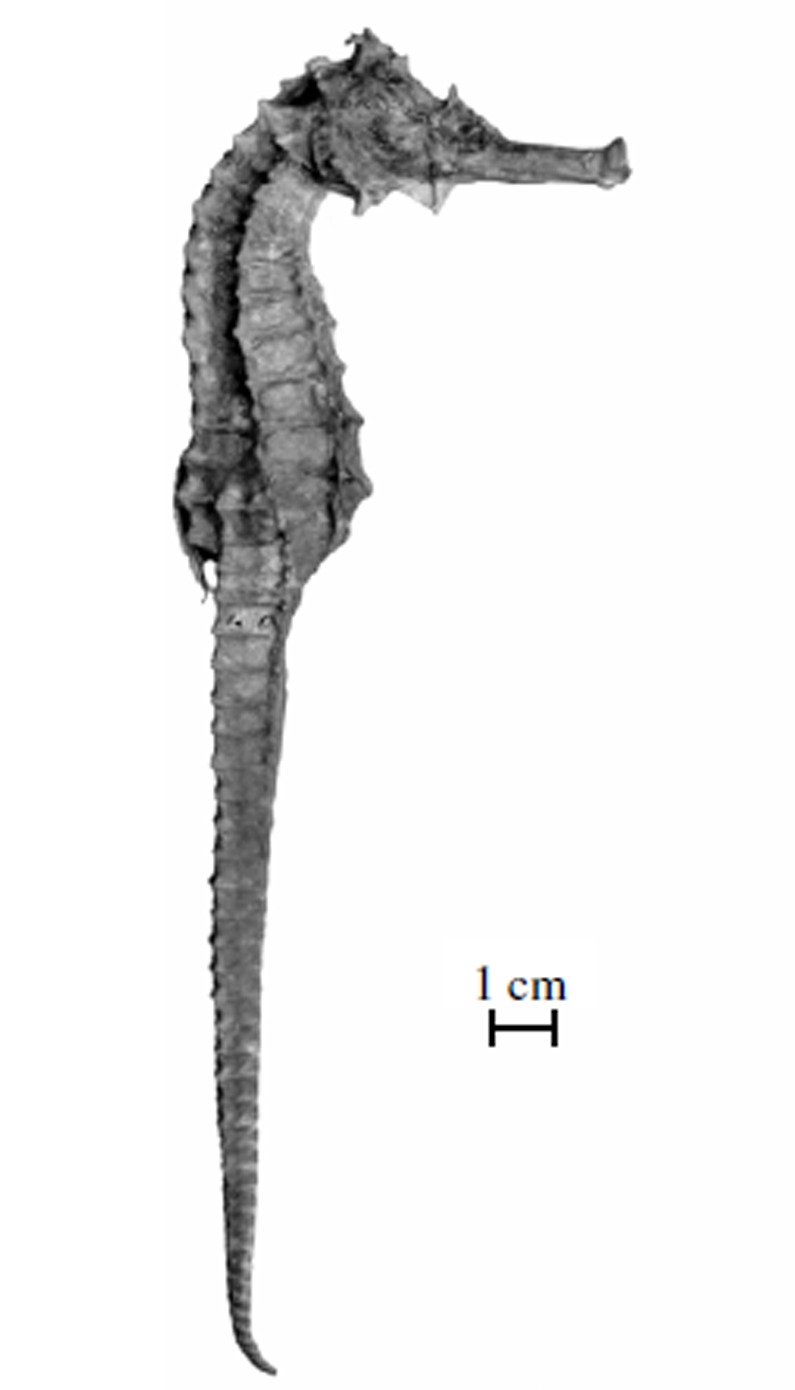
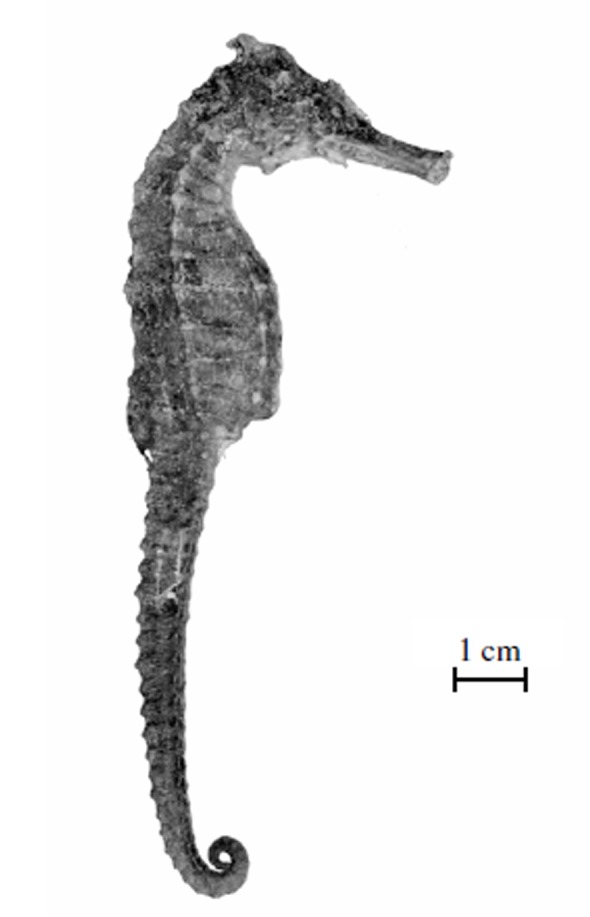
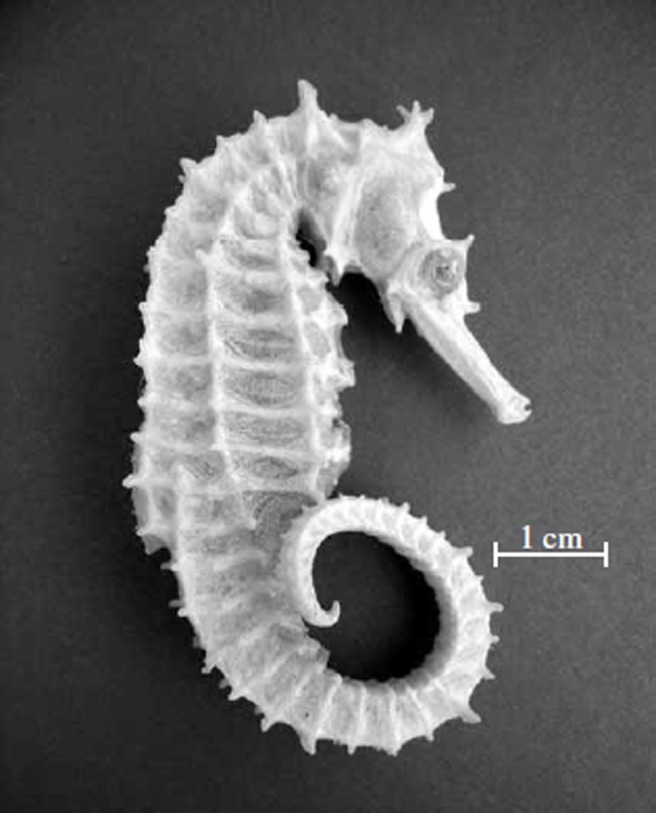
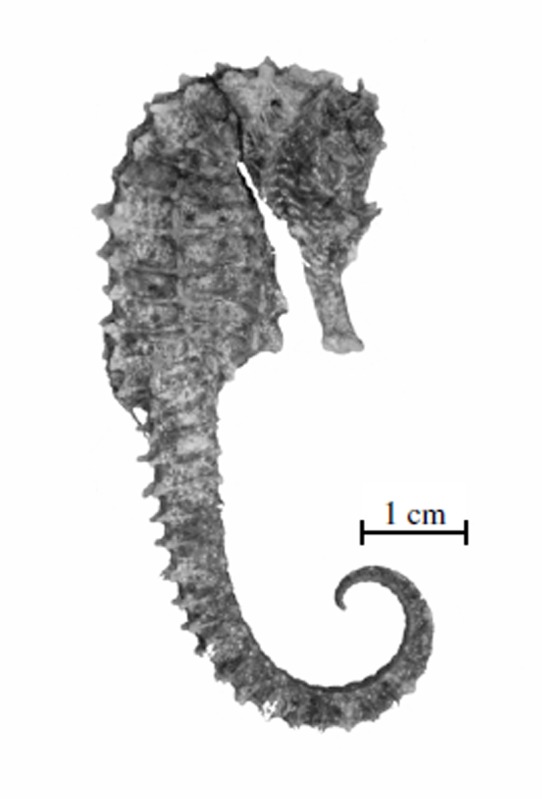
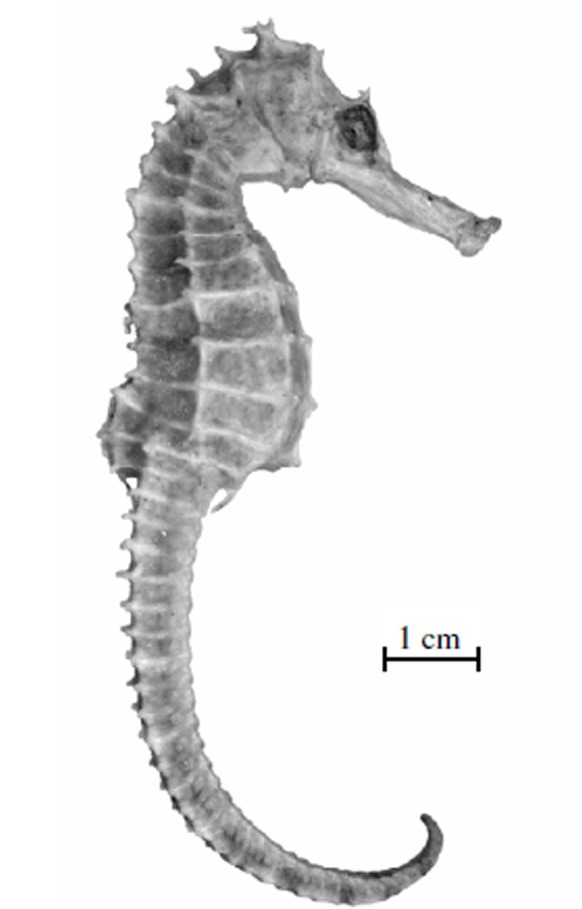
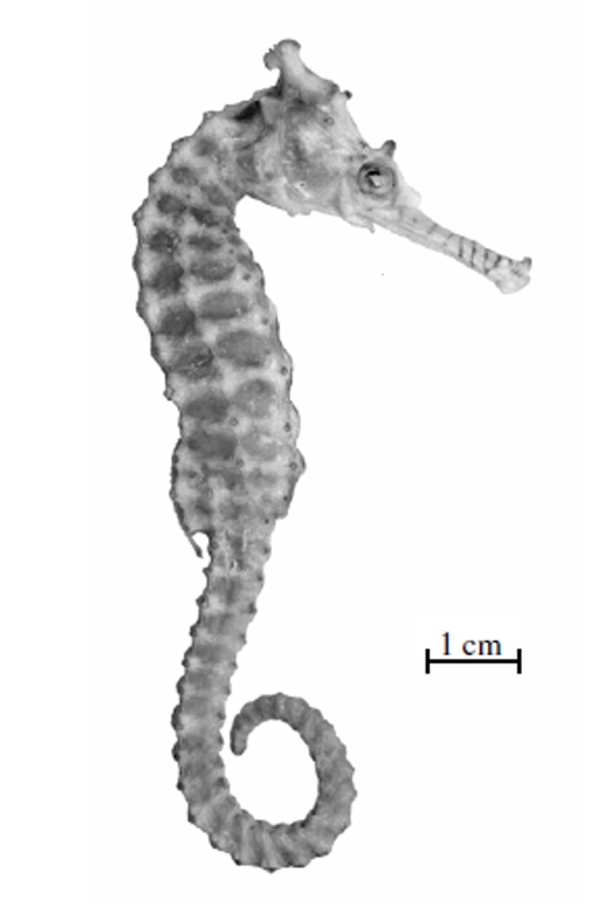
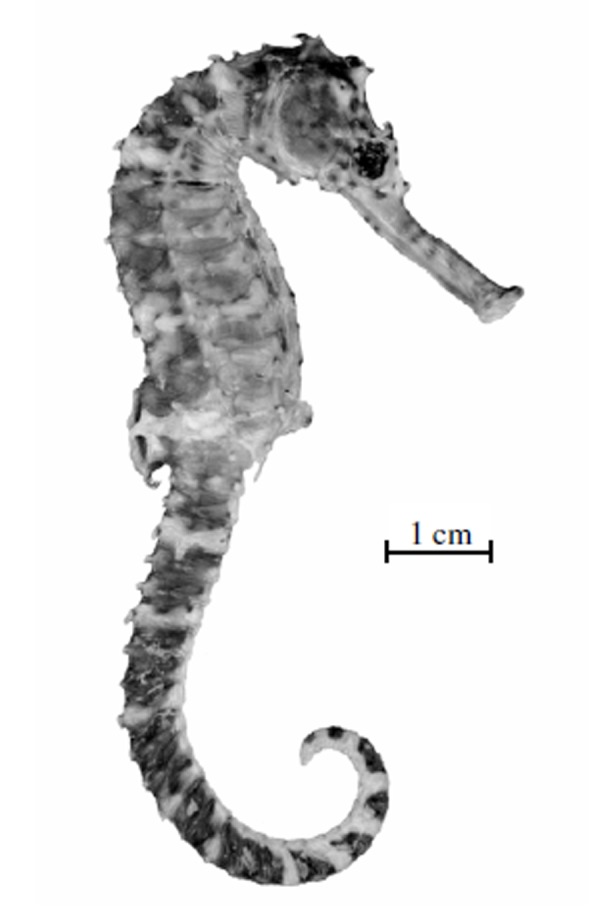
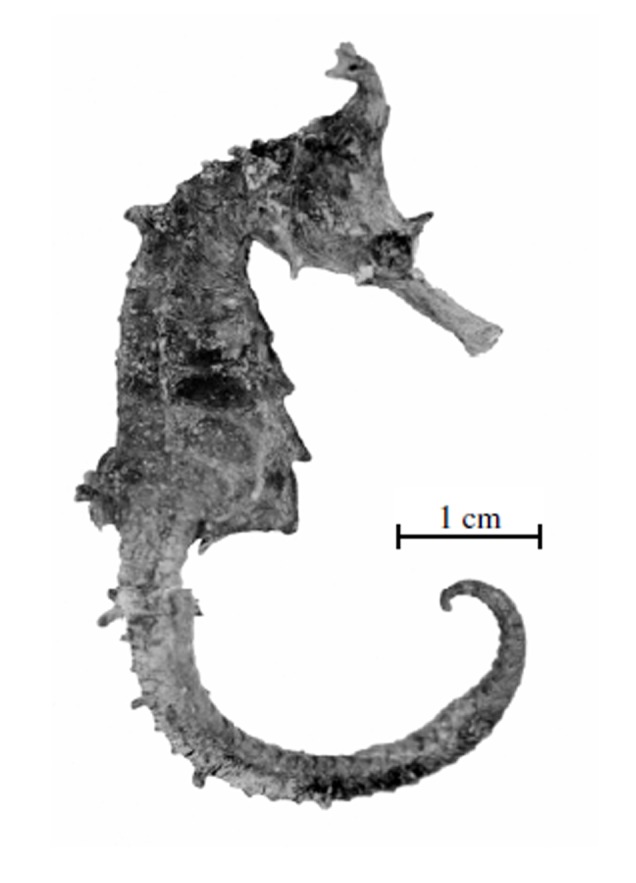
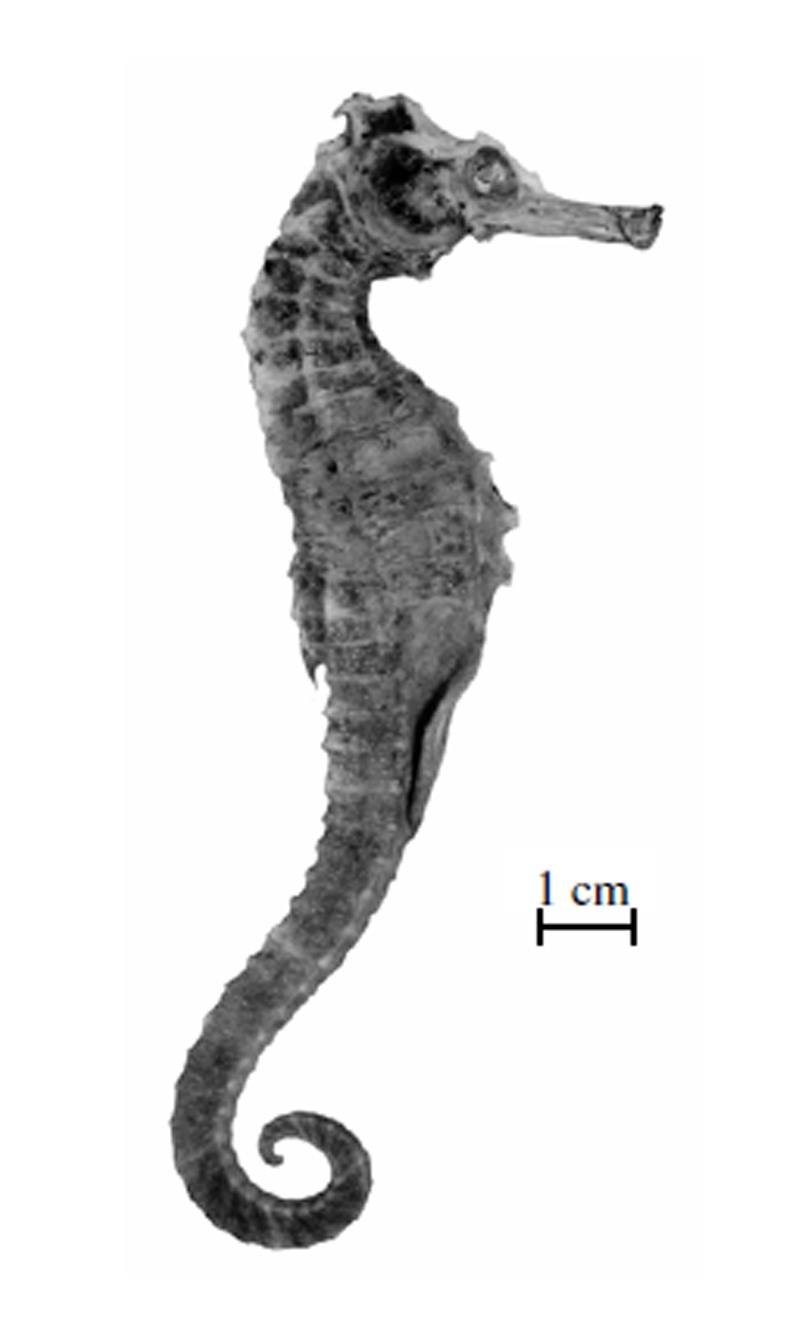
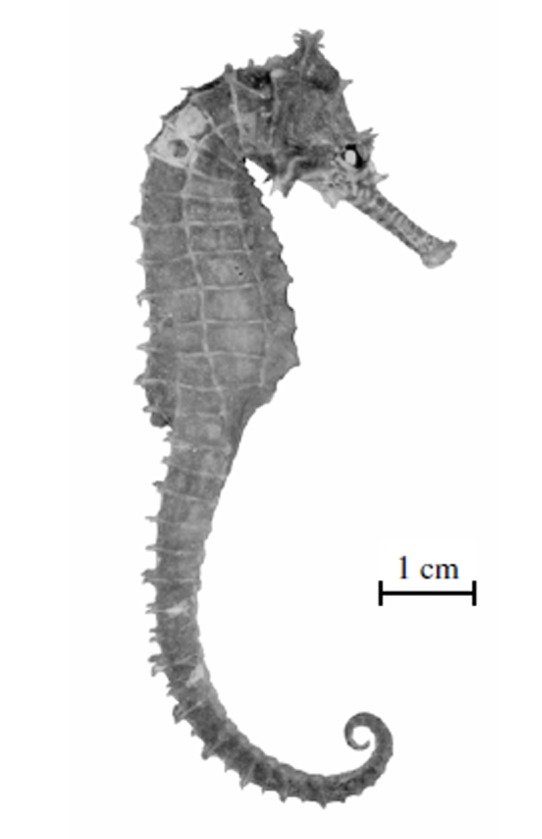
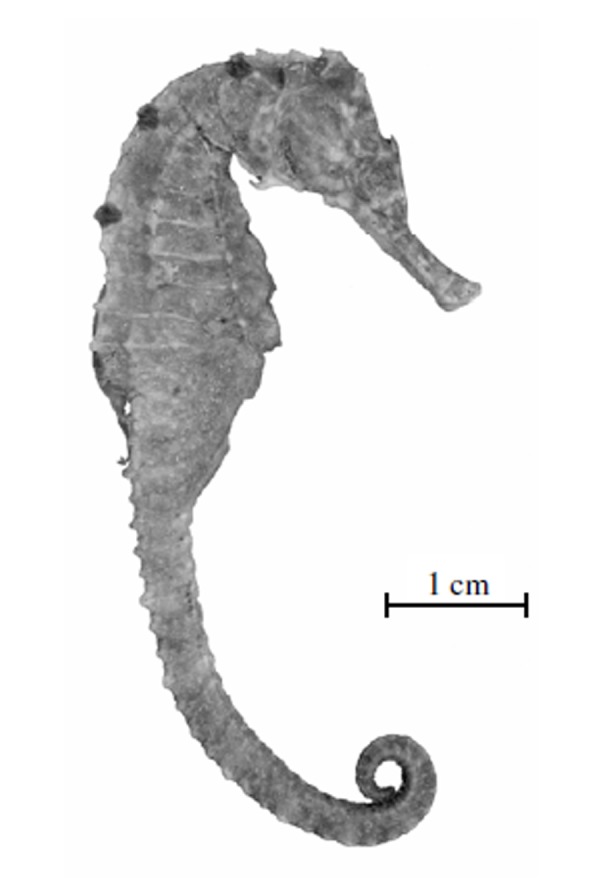
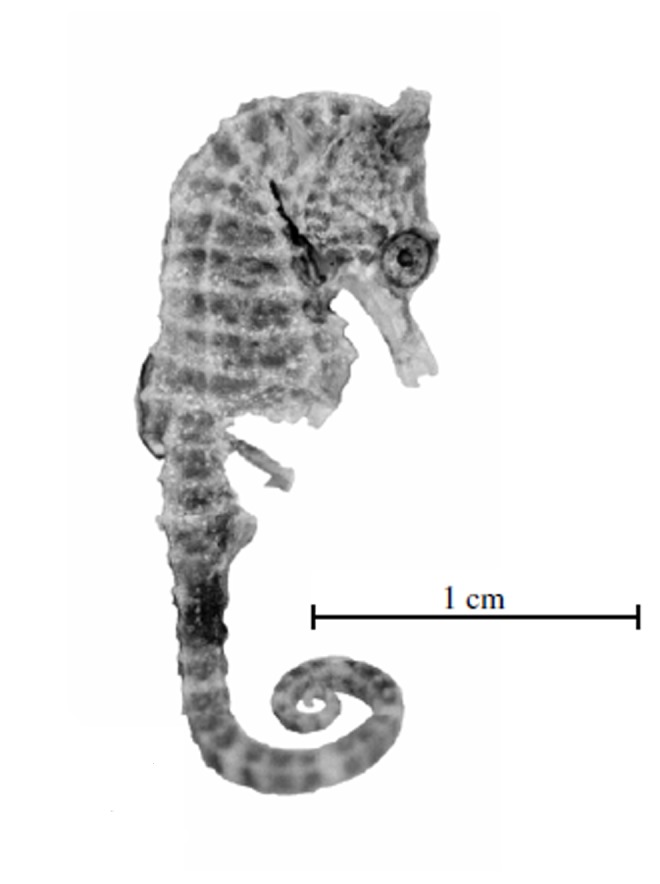
Photographic atlas of dried seahorses: (a) H. kelloggi; (b) H. kuda; (c) H. barbouri (bleached specimen); (d) Hippocampus borboniensis; (e) H. spinosissimus; (f) Hippocampus subelongatus; (g) H. comes; (h) Hippocampus coronatus; (i) Hippocampus algiricus; (j) H. barbouri; (k) H. trimaculatus; (l) Hippocampus zosterae (specimen has a damaged brood pouch). Source: Lourie et al. 2004
Statistical Analysis
A two-sample t-test was applied to compare the length differences between the two sexes in every collected seahorse species. The significance differences were tested at a 95% confidence interval.
RESULTS
The data were obtained from 11 interviews with sellers from the local market, a total of 315 dried seahorses (154 males and 161 females) that were borrowed and 18 fresh/live seahorses (10 males and 8 females) that were collected: 12 samples purchased from local fishers and 6 samples caught during direct samplings (Fig. 3). The seahorses were only found in three sampling stations: UMS Jetty, Gaya Island and Tanjung Aru (Table 1). Ten individuals of H. barbouri were found mainly in the outer fringes of the estuary of Gaya Island and Tanjung Aru, and one individual was obtained during sampling at the UMS Jetty at depths between 7 and 10 m. Meanwhile, all four individuals of H. comes were obtained from under the UMS Jetty and caught between 5 and 8 m through several diving trips. Two females of H. spinosissimus were found in a shallow reef flat at Tanjung Aru, with depths ranging between 8 and 10 m, according to the fisher’s memory. One female H. kuda was obtained around the UMS Jetty’s surroundings (approximately 1–3 m) during a direct sampling.
Figure 3:
The photographs of identified live specimens: (a) male H. barbouri; (b) female H. barbouri; (c) male H. comes; (d) female H. comes; (e) female H. spinosissimus; (e) female H. kuda.
Table 1:
Species composition and sexes of fresh/live and dried seahorse samples found in coastal waters and the local market of Kota Kinabalu.
| Types of sample | Fresh/Live | Dried | |||||||
|---|---|---|---|---|---|---|---|---|---|
|
| |||||||||
| Species | Sampling station | No. of individuals | (%) | Male | Female | No. of individuals | (%) | Male | Female |
| H. barbouri | Gaya Island, Tanjung Aru and UMS Jetty | 11 | 61 | 7 | 4 | 78 | 24.8 | 42 | 36 |
| H. comes | UMS Jetty | 4 | 22 | 3 | 1 | 52 | 16.5 | 20 | 32 |
| H. kelloggi | – | – | – | – | – | 24 | 7.6 | 14 | 10 |
| H. kuda | UMS Jetty | 1 | 6 | – | 1 | 14 | 4.4 | 9 | 5 |
| H. spinosissimus | Tanjung | 2 | 11 | – | 2 | 110 | 35.0 | 48 | 62 |
| Aru | |||||||||
| H. trimaculatus | – | – | – | – | – | 37 | 11.8 | 21 | 16 |
|
| |||||||||
| Total individuals | 18 | 315 | |||||||
Species Composition
Six species of seahorses were identified around the coastal waters and local market of Kota Kinabalu: H. barbouri, H. comes, H. kelloggi, H. kuda, H. spinosissimus and H. rimaculatus. The different species had unique and distinctive characteristics that differentiated them from one another based on the morphological identification of the fresh/live samples. All six species were identified in the borrowed dried samples. However, only four species were identified in the fresh/live samples: H. barbouri, H. comes, H. kuda and H. spinosissimus. H. barbouri was the most abundant species among all of the fresh/live samples, with 61% species composition. H. spinosissimus comprised 35% of the total species composition among the dried specimens, representing the most heavily exploited species. This was followed by H. barbouri (24.8%), H. comes (16.5%), H. trimaculatus (11.8%), H. kelloggi (7.6%) and H. kuda (4.4%). The small percentages of H. kelloggi and H. kuda in the collections suggested that there were relatively few of them in the wild (Table 1).
Size Composition and Sexual Size Dimorphism
For the fresh/live samples, H. comes was the largest among the four species, with a mean SL reaching 148.25±1.26 mm, whereas H. barbouri was the smallest species, with a mean SL of 129±7.81 mm. The length between the two sexes in H. comes and H. barbouri were similar and showed no sexual dimorphism in either species. Meanwhile, the length differences between males and females of H. spinosissimus and H. kuda could not be determined because only female specimens were available (Table 2).
Table 2:
Morphological analysis of fresh/live seahorse species found in Kota Kinabalu.
| Species | H. barbouri | H. comes | H. spinosissimus | H. kuda | ||||
|---|---|---|---|---|---|---|---|---|
| Sex | Male | Female | Male | Female | Male | Female | Male | Female |
| Height (mm) | 120–140 | 118–139 | 147–150 | 148 | N/A | 123–134 | N/A | 126 |
| Snout length (SnL) (mm) | 11–13 | 12–13 | 12–13 | 12 | N/A | 12–13 | N/A | 11 |
| Head length (HL) (mm) | 25–28 | 25–28 | 28–29 | 29 | N/A | 25–28 | N/A | 23 |
| HL/SnL | 2.0–2.3 | 2.1–2.2 | 2.3–2.4 | 2.4 | N/A | 2.1–2.2 | N/A | 2.1 |
| Tail rings | 33–35 | 33–35 | 35–36 | 35 | N/A | 17–18 | N/A | 35 |
| Dorsal fin rays | 16–19 | 17–20 | 18–19 | 17 | N/A | 17 | N/A | 17 |
| Pectoral fin rays | 15–18 | 16–18 | 17–18 | 16 | N/A | 11 | N/A | 16 |
| Trunk rings | 11 | 11 | 11 | 11 | N/A | 12 | N/A | 11 |
| Trunk rings supporting the dorsal fin | 2 | 2 | 2 | 2 | N/A | 1 | N/A | 2 |
| Tail rings supporting the dorsal fin | 1 | 1 | 1 | 1 | N/A | 1 | N/A | 1 |
| Cheek spines | 2 | 2 | 2 | 2 | N/A | 1 | N/A | 1 |
| Eye spines | 1 | 1 | 2 | 2 | N/A | 1 | N/A | 0 |
Note: NA - not available
For the dried samples, H. kelloggi was the largest, with an overall mean SL of 245.25±14.55 mm, and H. barbouri was the smallest, with an overall mean SL of 127.21±10.01 mm. H. kelloggi was the largest among the six species, with the mean SL for males and females reaching 240.57±15.88 mm (standard deviation [SD]) and 244.60±12.91 mm (SD), respectively. H. barbouri was the smallest, with a male mean SL of 125.21±10.51 mm (SD) and a female mean SL of 129.53±9.00 mm (SD). The second largest species was H. trimaculatus, with the mean SL for males and females reaching 171.33±12.78 mm (SD) and 167.50±10.51 mm (SD), respectively, followed by H. kuda, with the mean SL for males and females reaching 163.89±12.19 mm (SD) and 164.00±15.39 mm (SD), respectively. Meanwhile, the mean SL of H. comes was 147.90±13.47 mm (SD) for males and 145.66±11.80 mm (SD) for females. Lastly, the mean SL of male and female H. spinosissimus were 141.06±9.03 mm and 138.81±7.71 mm, respectively. There were no significance differences between the length of males and females in every seahorse species (p>0.05); therefore, the results showed no sexual size dimorphism in any of the species (Table 3).
Table 3:
Sizes of male (m) and female (f) dried seahorse of various species sold at Kota Kinabalu Salted Fish Market.
| Species | Sex | Mean SL ±SD (mm) | N | t Critical two-tail | P 95% confidence limit Sig. (two-tailed) |
|---|---|---|---|---|---|
| H. spinosissimus | m | 141.06±9.03 | 48 | 1.986 | 0.170 |
| f | 138.81±7.71 | 62 | |||
| H. barbouri | m | 125.21±10.51 | 42 | 1.992 | 0.055 |
| f | 129.53±9.00 | 36 | |||
| H. comes | m | 147.90±13.47 | 20 | 2.028 | 0.544 |
| f | 145.66±11.80 | 32 | |||
| H. trimaculatus | m | 171.33±12.78 | 21 | 2.030 | 0.324 |
| f | 167.50±10.51 | 16 | |||
| H. kelloggi | m | 240.57±15.88 | 14 | 2.074 | 0.501 |
| f | 244.60±12.91 | 10 | |||
| H. kuda | m | 163.89±12.19 | 9 | 2.365 | 0.989 |
| f | 164.00±15.39 | 5 |
Market Survey
A total of 11 respondents provided information on the catch methods, trade routes, origins, price, commercial value and uses of the local dried seahorses (Table 4). The dried seahorses were mostly obtained from the fishery by-catches and sold locally with a price up to RM100 per pair of seahorses, depending on the size and other physical attributes (e.g., colour). Approximately 80% of the respondents stated that dried seahorses sold in the market were originated locally, and 20% of the respondents referred to them as imported seahorses from neighbouring countries, such as the Philippines and Indonesia.
Table 4:
Responses from the local market survey.
| Topic | Information |
|---|---|
| Catch methods |
|
| Trade routes |
|
| Origins |
|
| Price | Dried: single (RM15 to RM35), by pair (RM25 to RM95) |
| Commercial value | The commercial values of the seahorses depended on the size and condition. Larger and coloured seahorses were sold at higher prices than smaller and bleached seahorses. |
| Uses |
|
DISCUSSION
The seahorse species compositions in the coastal waters of Kota Kinabalu were consistent with the species previously reported in Peninsular Malaysia (Choo & Liew 2003), as well as in East Malaysia (Choo & Liew 2004). Moreover, the species were also similar to those in neighbouring countries. For example, two species found in this study (H. spinosissimus and H. kuda) were documented in the waters of Vietnam, the Philippines and Indonesia (Lourie et al. 2004), as well as in the waters around Thailand (Natheewatana et al. 1993). Lourie et al. (2004) suggested that H. kuda was the most dominant species in the Indo-Pacific basin. In the present study, the species was not encountered often in either the field or market surveys, which might indicate fishing pressure on the species.
Ten species of the subfamily Hippocampinae were previously recorded in Malaysia, and all 10 of the confirmed species were also reported in Sabah (Lim et al. 2011; Choo & Liew 2004). Sabah waters have a relatively high diversity of seahorse species and contain almost all of the seahorse species in Southeast Asia, including pygmy seahorses, excluding only Hippocampus mohnikei (Lourie et al. 2004). Pygmy seahorses (e.g., Hippocampus bargibanti, Hippocampus denise and Hippocampus satomiae) were only spotted on the east side of Sabah around Semporna Islands (Lim et al. 2011). Faleiro and Narciso (2011) reported that, given the lack of sexual dimorphism in seahorse length, size-assortative mating can be advantageous and optimise the reproductive potential of seahorse couples. In Hippocampus erectus, males exhibited longer SL, shorter trunks with isometric growth, and longer tails with positively allometric growth. However, females demonstrated positive allometric growth of the trunk length and isometric tail length. There was no observed dimorphism in the weight-length relationship of this species (Andersen 2012).
The species distribution of seahorses was strongly dependent on habitat availability. Sabah has a rich marine biodiversity and complex coastal geomorphology (Lim et al. 2011) and offers a wide range of habitat types, which could explain the richness of seahorse diversity in Sabah when compared to other parts of Malaysia. There was a clear habitat separation for most species, and these habitats were generally consistent with those stated in Lourie et al. (2004). Interestingly, this study did not find any seahorses in the coral reef ecosystems at Layangan Island and Dinawan Island, which were dominated by scleractinian corals harbouring diverse fish species. In fact, they were often found in cryptic habitats, such as seaweeds and gorgonian corals. Food competition and predation could be the major causes that led seahorses to avoid inhabiting the scleractinian zone, because many coral reef fishes were either fast-swimming plankton eaters or piscivores. In addition, the feeding habits of many seahorse species, as slow-moving ambush predators, might be most successful in cryptic habitats. This study provided some inferences as to the distribution of seahorse species in areas not covered by this particular survey, which would be useful for further investigation and for management and conservation purposes.
H. barbouri could be found in waters off most of the islands and in shallow bays or lagoons in Sabah, because Halimeda sp. seaweed (their associated substrate) is likely to thrive in such areas (Choo & Liew 2004). In contrast, H. comes could be widespread in the shallow reef along Sabah coastlines and islands (Choo & Liew 2004), but fish bombing, which is practised in some areas, could severely impact the whole population of this species, which is known to be extremely site-faithful (Perante et al. 2002). In addition, H. kuda was extant in Sepanggar Island in the past, where there used to be abundant tropical eelgrass (Choo & Liew 2004). However, there were none found in the areas, most likely because the seagrass beds were heavily perturbed by boat activities, fish bombing, netting, and dredging for land reclamation. Therefore, H. kuda populations that previously existed are probably severely decimated. Labuan Island and several estuaries on the northeast of Sabah, and perhaps the estuaries in Sarawak, might harbour populations of H. kuda. Therefore, future work should aim at investigating these areas, with more sampling frequency at different sampling sites.
Currently, 38 species of seahorses worldwide are listed in the 2012 International Union for Conservation of Nature (IUCN) Red List of Threatened Species (IUCN 2012). The six seahorse species found during the present study are all listed as vulnerable on the 2012 IUCN Red List. The current overexploitation of seahorses is largely due to the market demand for traditional Chinese medicine (TCM) or traditional medicine (jamu and folk medicine), souvenirs and other activities, as proven by the market survey data from the findings. Any Hippocampus sp. that are available are traded as TCM, jamu and folk medicine and believed to be the highest in medicinal value and the most valuable for the trade among other syngnathids, such as pipefishes (Vincent 1996). Indeed, Malaysia is touted as an important supplier of seahorses (Perry et al. 2010), together with pipefishes and pipehorses (Martin-Smith et al. 2003).
Given the increasing anthropogenic threats to the Malaysian ichthyofauna (Chong et al. 2010), integrated coastal or ecosystem-based management seems more urgent than ever to help conserve the local seahorses and fishery resources in general. Two species of seahorses from the study (H. barbouri and H. spinosissimus) were found to inhabit macroalgae at some distance from Marine Park Islands, such as Tunku Abdul Rahman Park. Thus, it appears that with good enforcement, Marine Protected Areas can play a vital role in protecting some species of seahorses and their habitats. Moreover, mangrove areas, coral reefs and seagrass beds in estuaries act as sanctuaries for some seahorse species and must be protected and managed wherever possible. These are the prime habitats for many seahorse species, so the loss and degradation will affect the fish. Additionally, undeveloped areas that support remnant seahorse populations should be preserved. Artificial reefs are also likely shelters for seahorses, as divers have reported them in concrete and tyre man-made reefs (Choo & Liew 2005). When established near gorgonian beds, artificial reefs could also boost seahorse populations and repel local extinction. In addition, culturing seahorses is also an option to reduce the pressure on wild seahorses. The demand for seahorses cannot be met by harvesting the wild stock; as a result, it is important to establish a seahorse farm (Vincent 1996).
CONCLUSION
In summary, six species of seahorses were identified around the selected coastal waters and local market of Kota Kinabalu, and these species were also found in other parts of Malaysia. All six species were traded as dried seahorses in the market and used for various purposes. H. kelloggi was the largest among the six species, and H. barbouri was the smallest. There was no significant difference in the lengths between the males and females in every species, and no sexual size dimorphism was detected in any of the species. In conclusion, the findings from this study are significant to support seahorse conservation efforts.
Acknowledgments
This study was funded by the Malaysian Ministry of Higher Education (MoHE) through the Fundamental Research Grant Scheme, FRG0275-SG-2/2010. We would also like to express our gratitude to the Borneo Marine Research Institute, Universiti Malaysia Sabah for the provided laboratories and facilities.
REFERENCES
- Andersen PA. Sexual dimorphism in morphometry and allometry of the adult lined seahorse, Hippocampus erectus. Copeia. 2012;2012(3):389–393. [Google Scholar]
- Chong VC, Lee PKY, Lau CM. Diversity, extinction risk and conservation of Malaysian fishes. Journal of Fish Biology. 2010;76(9):2009–2066. doi: 10.1111/j.1095-8649.2010.02685.x. [DOI] [PubMed] [Google Scholar]
- Choo CK, Liew HC. Spatial distribution, substrate assemblages and size composition of sea horses (Family Syngnathidae) in the coastal waters of Peninsular Malaysia. Journal of the Marine Biological Association of the United Kingdom. 2003;83(2):271–276. [Google Scholar]
- Choo CK, Liew HC. A record of seahorse species (Family Syngnathidae) in East Malaysia, with notes on their conservation. Malayan Nature Journal. 2004;56(4):409–420. [Google Scholar]
- Choo CK, Liew HC. Exploitation and trade in seahorses in Peninsular Malaysia. Malayan Nature Journal. 2005;57(1):57–66. [Google Scholar]
- English S, Wilkinson C, Baker V. Survey manual for tropical marine resources. Townsville: Australian Institute of Marine Science; 1994. [Google Scholar]
- Faleiro F, Narciso L. The bigger the better: An assessment of reproductive potential in seahorses. Reproduction, Fertility and Development. 2011;2:37–44. [Google Scholar]
- International Union for Conservation of Nature (IUCN) IUCN red list of threatened species (version 2012) 2012 http://www.iucnredlist.org (accessed on 18 November 2012). [Google Scholar]
- King M. Fisheries biology, assessment and management. Oxford: Fishing News Books; 1995. [Google Scholar]
- Lim ACO, Chong VC, Wong CS, Choo CK. Diversity, habitats and conservation threats of syngnathid (Syngnathidae) fishes in Malaysia. Tropical Zoology Journal. 2011;24(2):193–222. [Google Scholar]
- Lourie SA, Foster SJ, Cooper EW, Vincent ACJ. A guide to the identification of seahorses. Washington DC: Project Seahorse and TRAFFIC North America, University of British Columbia and World Wildlife Fund; 2004. [Google Scholar]
- Martin-Smith KM, Lam TF, Lee SK. Trade in pipehorses Solegnathus spp. for traditional medicine in Hong Kong. Traffic Bulletin. 2003;19(3):139–148. [Google Scholar]
- Natheewatana A, Aungtonya C, Sirivejabundhu R. Revised checklist in the reference collection of Phuket Marine Biological Center, Department of Fisheries, Thailand. Phuket Marine Biological Center Special Publication. 1993;12:9–34. [Google Scholar]
- Perante NC, Pajaro MG, Meeuwig JJ, Vincent ACJ. Biology of a seahorse species, Hippocampus comes in the central Philippines. Journal of Fish Biology. 2002;60(4):821–837. [Google Scholar]
- Perry AL, Lunn KE, Vincent ACJ. Fisheries, large-scale trade, and conservation of seahorses in Malaysia and Thailand. Aquatic Conservation: Marine and Freshwater Ecosystems. 2010;20(4):464–475. [Google Scholar]
- Shapawi R, Tinin A, How SE. Total polyphenpol content, anti-oxidative and anti-bacterial properties of seahorses traded as traditional medicine. International Journal of Natural Products Research. 2013;3(3):68–73. [Google Scholar]
- Vincent ACJ. The international trade in seahorses. Cambridge: TRAFFIC International; 1996. [Google Scholar]



